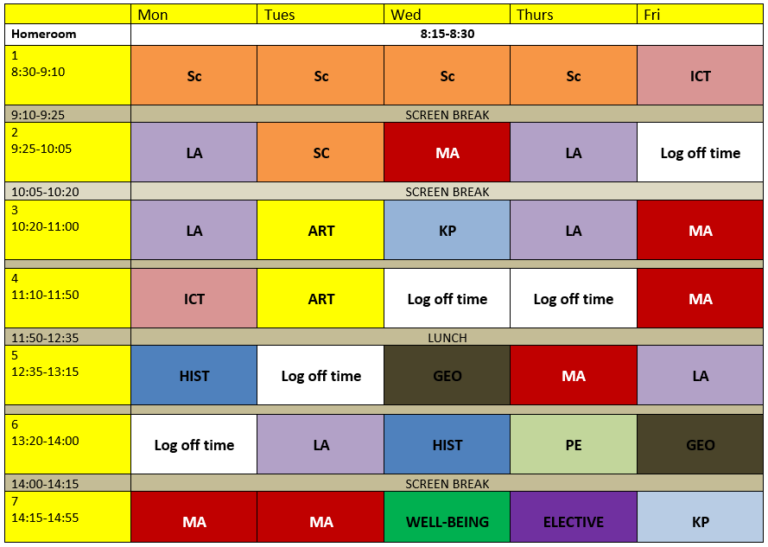Grade 6
Welcome to the Grade 6 page
Below you can find out a little more about school life and what we get up to in Grade 6
Homeroom Teacher

Ms Sheena Oczon
Grade 6 Teacher
Curriculum Overview
Language Arts
Grammar
Students will build on grammar practice in grade 5 to include:
- Use of correct capitalization, punctuation, and spelling when writing
- Understanding of Pronouns – subjective, objective, possessive and intensive
- Use correct punctuation to include commas, parentheses, and dashes
Reading
- Quote text to show evidence.
- Summarize ideas/themes
- Analyse developments
- Interpret words and phrases
- Analyse texts structure
- Point of view, purpose, content and style
In addition to course textbooks class novels will include:
- Bridge to Terabithea (Katherine Patterson)
- The Adventures of Huckleberry Finn (Mark Twain)
Speaking & Listening
- Apply clear and persuasive conversation
- Integrate diverse media
- Evaluate points of view, reasoning, + use of evidence and rhetoric
- Adapt speech to contexts
Writing
- Support claims with evidence
- Informative/explanatory
- Use of narratives
- Establish task, purpose, and audience
- Use technology to produce and publish
- Focused questions
- Gather information to assess credibility and accuracy
History
- Explain what history is
- Analyze and interpret timelines, artifacts, secondary and primary sources
- The History of Medicine Ancient – Renaissance
- Understand the causes and consequences of the Age of Revolution in the late 18th and early 19th centuries
- Analyze the influence of the French, American revolutions, on the transformations in Europe and the world
- Analyze the geographic, political, economic, social, and religious structures of the civilizations of Ancient India
Geography
- Analyze theories that explain how the Earth is formed; explain development of life on Earth; describe and interpret the geological timescale
- Understand that the Earth is being changed by natural processes and human activities
- Explain the different ways how humans are connected to each other
- Compare different types of maps; interpret and analyze different information given on a map
- Use a map accurately to locate places and measure distances between two points on a map
Physical Education
- Use their hands to pass and receive at speed combined with running and changes in direction.
- Implement controlled foot-dribbles or dribbles; dribble with dominant hand while changing speed.
- Perform a legal underhand serve with control for net and wall games such as badminton or volleyball.
- Employ correct techniques and methods of stretching.
- Exhibit personal responsibility, demonstrating respect for facilities and exhibiting safe behaviour.
- Demonstrate respect for self and others by following the rules
Art
Drawing
- Explore and begin to develop the qualities of line and shape.
- Identify different views in perspective drawing; front, side, back, and bottom view.
- Demonstrate how to draw one and two point perspective.
Painting
- Explain abstract painting and differentiate abstract and abstract figurative painting.
- Apply skills and techniques using different materials in abstract painting.
- Learning color combination from primary to secondary and discovering new colors in painting.
Arts and Crafts
- Create an artwork utilizing materials and invent a unique design.
Science
Life Science
- Classify organisms according to Domain and Kingdom Systems
- Explain the parts/ structures involved in the senses of hearing and seeing
- Demonstrate the proper way of taking care of the eyes and ears
Physical Science
- Learn how to use basic tools to measure physical quantities like mass, length and volume
- Classify matter according to mixtures and pure substances
- Investigate the properties of light and sound
Earth and Space Science
- Understand how natural resources are classified, utilized and practice ways to protect, and conserve them for the future generations/ sustainability
- Identify the parts of the ocean floor and explain how the ocean water moves
- Investigate the different ocean water ecosystems (intertidal zone, coral reefs etc.)
- Compare the different members of the Solar System and the Universe
Mathematics
Number system
- Be able to add, subtract, multiply, divide, and compare whole numbers and decimals, rational numbers, and fractions; Integers; Absolute value
Relationships between variables
- Understand, determine and write dependent and independent variables
Ratios and Rates
- Model and write equivalent ratios
- Find and use unit rates
and percentages - Transform units of measurement
Geometry
- Find area of 2D shapes
- Find surface area and volume of 3D shapes
Expressions and Equations
- Write and evaluate exponents
- Solve equations and inequalities
Data
- Display data in dot plots
- Understand the mean and centre of data
- Display data in box plots
ICT
Microsoft Excel
- Discuss MS Excel toolbars
- Merge cells and wrap text
- Format cells, rows, columns
- Insert tables, pictures, clip arts, shapes
- Insert graphs, equations and symbols
- Work with formulas
- Introduce basic Statistical Analysis using MS Excel
- Print a file
KP
Geography
- Draw and identify the Philippine Islands.
- Learn the Geographical Features of the Philippines.
- Know the Legendary story of Panay Island in the Visayas (Maragtas Epic Story)
Culture
- Discover the Life of Early Filipinos (Stone Age, New Stone Age, Metal age).
- Lear the basic Filipino language (Ilonggo)
History
- Explain the reasons of the Spanish, Japanese and American Occupation; Including the life of Dr. Jose Rizal
Government
- Explain the structure and function of the Philippine Government. Describe the forms of government and systems of Education for Early Filipinos

